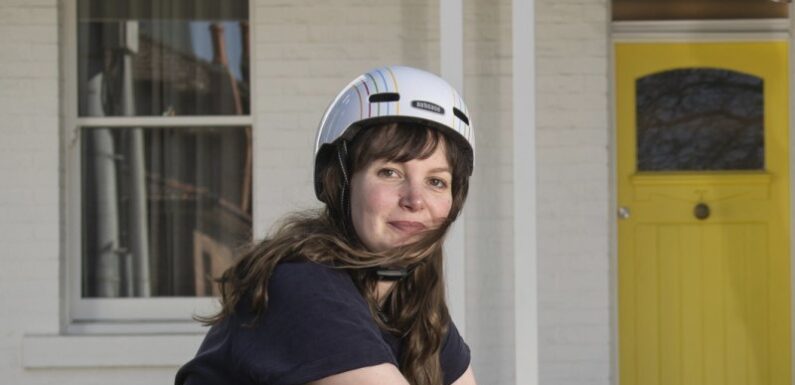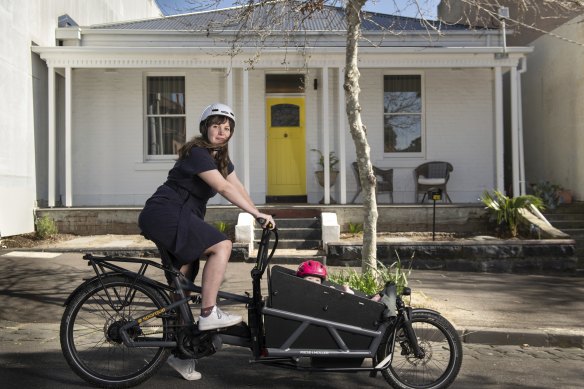
Save articles for later
Add articles to your saved list and come back to them any time.
A failure to make key cycling routes safer is stopping Melburnians from choosing bikes as an alternative to cars for short trips around town, according to the state’s peak motoring body.
Despite a rapid and controversial rollout of bicycle lanes in the inner-city during the COVID-19 pandemic, the RACV is among those concerned the construction of proposed cycling “corridors” across Melbourne is happening too slowly.
Mali Lewis with seven-month-old daughter Bea on their bike in a dedicated lane in Abbotsford St, North Melbourne.Credit: Penny Stephens
Around 60 per cent of Victorians are interested in cycling as a form of transport but are afraid to ride alongside motor vehicle traffic, state government surveys have found.
But RACV’s head of policy James Williams said many of the key routes in the state government’s own “strategic cycling corridor” have not been upgraded to separate cyclists from traffic with bollards or parked cars.
The motoring group surveyed 5000 Melburnians earlier this year about road safety concerns and found four of the city’s worst spots were on the cycling corridor network: Barkly and Hopkins streets in Footscray; the Haymarket “roundabout of death” at the end of Royal Parade; the Bay Street/Liardet Street intersection in Port Melbourne, and St Kilda Road.
Williams said the RACV wanted to see increased investment in building a corridor network which novice riders would feel comfortable on.
“From our perspective… it’s healthier, it’s more sustainable, it’s affordable, it’s better for your well-being,” he said. “But for everyone else on the road… it’s one less car, it’s reducing congestion and it’s better for everyone.”
Mali Lewis has regularly cycled for the past six years but tries to stick to protected bike lanes or quiet backstreets since getting a cargo bike to take her seven-month-old daughter Bea with her too.
The highschool teacher said that can be challenging from her South Melbourne home because of the patchwork of protected lanes, and she was disappointed that concerns about the loss of traffic lanes have killed plans for a separated lane along Kerferd Road.
“I’ve been using the separated lanes along St Kilda Road and it’s so much better and so much safer — but then you get to St Kilda Junction and you’re just on the Nepean (Highway),” she said.
Lewis said cycling meant she and her husband could avoid the cost of buying and running a second car.
“We also want to at least feel like we’re helping the environment a little bit — I also hate sitting in traffic, I’d much rather be out having fun on my bike,” she said.
Around 10 per cent of people living in the inner-city and 3 per cent across greater Melbourne cycled to work in 2020, according to the Victorian Integrated Survey of Travel & Activity. The Andrews government has said it would increase cycling and walking from 18 per cent of all journeys to 25 per cent by 2030 as part of its climate change policies.
The state government started working on a “strategic cycling corridor” network in 2015 linking suburbs, the CBD and major activity centres and said it would prioritise them for investment in safety upgrades.
Bicycle Network CEO Alison McCormack said that although it was encouraging that parts of the long-awaited St Kilda Road bike lane were recently opened, there was no clear plan for what would be built next.
“A proper investment plan would always have one project in planning, one in design and one in construction,” she said. “Instead, bike projects have been stop-start and disjointed and delayed.”
Dropping the Shrine to Sea path on Kerferd Road was a “such a backwards step when other cities around the world are forging ahead with high-quality bike infrastructure and seeing tremendous success,” McCormack said.
The City of Melbourne built almost 20 kilometres of new protected bike lanes in the city centre between 2020 and 2022 but paused the program in the Hoddle Grid after complaints from some traders and delivery drivers that it increased congestion and reduced parking.
VicRoads also installed more than 100 kilometres of temporary “pop-up” lanes since 2020 including on Heidelberg Road, and in parts of Footscray and Moonee Ponds. Around 40 kilometres of lanes in inner-bayside suburbs were ripped up after a backlash from some residents.
Transport Workers Association Victorian branch assistant secretary Mem Suleyman said new bike lanes without loading zones had made it harder for delivery workers to do their job, and called for better consultation before any more were built.
“Workers are fed up because it’s becoming more and more dangerous to carry out their work,” he said. “If you are going to install them, do it with a common-sense approach.”
A spokesperson for the Department of Transport and Planning said it was working with local councils to decide future priorities for cycling corridors, but could not say how much of the network had been upgraded.
They said that more than 180 kilometres of walking and cycling connections had been built as part of major infrastructure projects, including underneath elevated “skyrail” train lines, with 320 kilometres more planned, she said.
Bicycle trips had increase 20 per cent on Heidelberg Road since pop-up lanes were installed, and trips on St Kilda Road were up to three times higher since its separated lane opened in July.
“We know that delivering a safer, better-connected active transport network is key to encouraging more people to ride a bike,” they said.
Infrastructure Victoria CEO Jonathan Spear said 200,000 short car or public transport trips in Melbourne every day could be walked or cycled instead, which would ease congestion on local roads and crowding on public transport.
The government adviser’s called on the state two years ago to increase its spending on cycling paths from a “relatively small” $20 million per year (plus the $16 million it was spending on pop-up lanes) to $50 million to $100 million between 2021 and 2031.
“Something different is going to have to be done if we’re going to increase the shift to active transport,” he said.
Spear said backlash against cycling lanes causing road congestion did “do not actually reflect how the transport network operates”.
“The more road lanes you build, the more people drive and the more congestion there is,” he said. “So we should be providing opportunities for all sorts of choices for travelling, which includes delivering more cycling lanes.“
Twelve cyclists were killed in crashes on Victorian roads last year and 350 more were hospitalised with injuries, according to the Transport Accident Commission.
Many cities have embarked on aggressive programs rolling out bicycle lanes in recent years in an effort to reduce car congestion and emissions. In London, which started building “cycle superhighways” a decade ago, rates of cycling grew 18 per cent between 2019 and 2022.
Even Huston, Texas has plans to build almost 2900 kilometres of bike lanes across a city long considered a poster child for urban sprawl and car dependency.
The Morning Edition newsletter is our guide to the day’s most important and interesting stories, analysis and insights. Sign up here.
Most Viewed in National
From our partners
Source: Read Full Article
